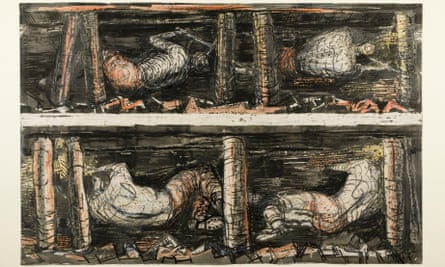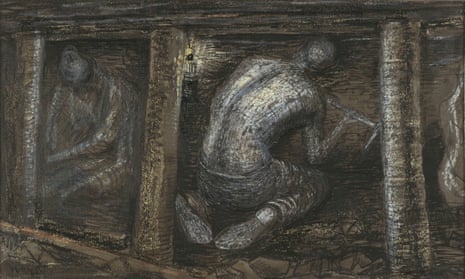He is one of Britain’s greatest sculptors, celebrated for his modernist representations of the female form. But Henry Moore had a little-known dark side: drawings of coalminers created from a week spent in the gloom of a Yorkshire pit in the wartime winter of 1941-42.
They depict the back-breaking, dangerous work carried out daily by hundreds of thousands of miners making a vital contribution to the war effort. Moore described the conditions 1,400ft underground as “like hell”.
Eighty years after his drawings were completed for the War Artists’ Advisory Committee (WAAC), more than 100 sketches and finished works have been brought together for the first time in an exhibition at St Albans Museum + Gallery. A book has been published, Drawing in the Dark: Henry Moore’s Coalmining Commission, by the art historian Chris Owen.
Moore was one of eight children whose father worked as a miner at Wheldale colliery in Castleford, West Yorkshire. In January 1942, after 20 years in London, Moore returned to the pit, spending a week underground making quick sketches of miners at work, from which he later created finished drawings.

“Moore was brought up in a tight-knit, socialist-leaning mining community. His father was an official in the embryonic miners’ union, and was instrumental in an 18-month strike when Moore was a child. So this commission was personal to Henry Moore,” Owen said.
“But by the time he went down the pit to make the drawings, he’d been immersed in the bohemian milieu of Hampstead in the 1930s. Going back must have been a strange experience.”
The WAAC, a government agency headed by the art historian Sir Kenneth Clark, commissioned a number of artists, both on the home front and with forces abroad. Stanley Spencer painted shipbuilders on the Clyde for the WAAC; Graham Sutherland recorded workers at the Cornish tin mines.
Moore had already made a reputation for his sketches of people sheltering from the blitz in London’s underground stations by the time he went home to Castleford.

“He made about 90 quick sketches in his ‘pit notebook’. He was interested in how miners worked, their poses as they cut into the coalface, the way they knelt or lay on their sides. There was very little mechanisation then, mining was a quite primitive process of hewing,” Owen said.
“We can easily underestimate how difficult it was to draw when there was almost no light, just a headlamp. He wanted to show the darkness, and this was challenging, both physically and artistically.”
Moore later described “a dense darkness you could touch, the whirring din of the coal-cutting machine, throwing into the air black dust … all in stifling heat. I have never had a tougher day in my life.”
His pit notebook, on display in the exhibition, shows his preliminary sketches of the miners’ day: bodies contorted to cut the seam in claustrophobic spaces; pushing tubs of extracted coal; eating their “snap” and resting; queueing for cages to return them to the surface.
after newsletter promotion

Over several months, he created 28 finished drawings from his sketches. Some were shown by the WAAC in the National Gallery – whose oil paintings had been safely removed to storage for the war – and then in travelling exhibitions. At the end of the war, the WAAC distributed the works it had commissioned to galleries and museums around the country.
Owen said Moore’s coalmining drawings had perhaps been “disregarded in the past, seen as a digression from his sculptural work”. But he added: “They’re beautifully observed, with subtle transitions of light, exactly capturing the miners’ postures and the male form.”
Moore said he had never “willingly drawn male figures before”. But in Wheldale, he said, “I discovered the male figure and the qualities of the figure in action”.
Owen said: “This was the only time when Moore really explored his background. He doesn’t seem to have been close to his father, but Moore had a lot of sympathy for these miners. He didn’t say much about his private thoughts, so we only know what we pick up from his drawings. But I think this series shows that even as a wealthy and successful artist, Moore continued to value his father’s socialist beliefs.”
Henry Moore: Drawing in the Dark is at St Albans Museum + Gallery until 16 April, free. The exhibition is curated by University of Hertfordshire Arts + Culture.
